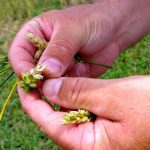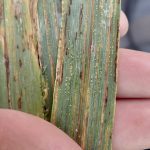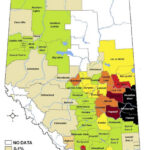A biological sample that a Chinese researcher was accused of smuggling into the United States and that prosecutors cast as a “dangerous biological pathogen” is a common type of fungus already widespread in U.S. crop fields that likely poses little risk to food safety, experts said.

Experts doubt FBI’s claim that crop fungus smuggled by Chinese students is a threat

Two Chinese researchers accused of smuggling ‘potential agroterrorism weapon’ into U.S.
Fusarium poses threat
U.S. federal prosecutors have accused two Chinese nationals of smuggling a dangerous biological pathogen that had the potential to be used as an agricultural terrorism weapon into the United States for research.

Back to normal for cereal leaf disease in Saskatchewan
Precipitation has more or less returned to normal in Saskatchewan, but that also means cereal growers need to be more aware of leaf and other diseases, says a plant pathologist.

Fusarium head blight mapping tool to limit fungal risk
Homegrown risk model offers platform for further disease research
Reading Time: 2 minutes The digital mapping tool is designed to give area-specific insights into the fungal disease. Cereal producers can get a localized head blight index and risk level for fusarium-damaged kernels and deoxynivalenol based on weather conditions.

CMBTC study finds new malting barley lines a fit for Manitoba
Agronomic traits in new varieties overcome disease issues that held crop back
Manitoba farmers have improved prospects to access the more-lucrative malting barley market, according to a recent study. The report by the Canadian Malting Barley Technical Centre (CMBTC), in collaboration with the Manitoba Crop Alliance, says new Canadian malting barley varieties can be grown successfully in Manitoba. With yields and quality comparable to the check variety […] Read more

Low fusarium levels detected in seed
Reading Time: < 1 minute Testing conducted last year for fusarium-infected seed found only low levels in the province, according to an interim report from Alberta Seed Processors. Three labs tested samples collected from Sept.1 until the end of the year, the organization said on its website. “Even though wheat samples tested had the presence of fusarium, infection levels were […] Read more

Rains were welcome but bring increased threat of crop diseases
There are host of factors to consider before spraying but get out in the field and look closely, says expert
Reading Time: 4 minutes Recent rainfall means farmers need to scout their crops and make decisions about spraying. “Certainly the rain that we’ve had would get things going,” said Kelly Turkington, a plant pathologist at Agriculture Canada’s Lacombe research station. For example, leaf spot diseases in barley and wheat can quickly flare up, he said on July 13. “Within […] Read more

A small silver lining in 2021: Drought pushes down fusarium levels
And planting fusarium-free seed gives growers a chance to push them down a bit further
Reading Time: 3 minutes Last summer’s drought drove down fusarium head blight levels across the province. But it’s still lurking, and increasingly that’s happening in parts of the province that have been spared in the past. “This year, just over five per cent of samples that we’re testing from Alberta have been positive for fusarium graminearum,” said Trevor Blois, […] Read more

East side of province comes out worst in fusarium survey
Survey aims to help farmers better assess FHB risk and manage it
Reading Time: 2 minutes Alberta Seed Processors has released its final report on fusarium graminearum (Fg) seed infection survey results. These results are part of a new phase of fusarium head blight (FHB) management in Alberta. The project was launched in the fall of 2020 with the goal of better understanding how farmers can manage, control and prevent the devastating disease. […] Read more

Opinion: Every producer needs to manage fusarium levels on their own farms
Fusarium testing of last year’s crops found very high levels of infection in many areas
Reading Time: 2 minutes Last year, fusarium was removed from the Alberta Agriculture Pest Act. This was a clear signal from our provincial government that regulating the disease was not an effective way to prevent or even manage it. While a paradigm shift, this was a positive development for our industry. It meant the focus would transition to managing […] Read more

